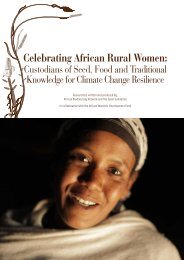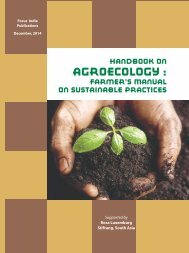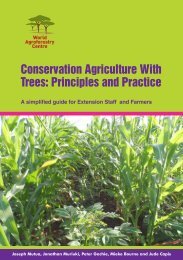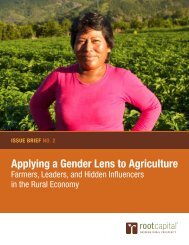1t0SC7l
1t0SC7l
1t0SC7l
Create successful ePaper yourself
Turn your PDF publications into a flip-book with our unique Google optimized e-Paper software.
5 SOLUTIONS TO FARMERS’ PROBLEMS AND FOR SUSTAINABLE<br />
LAND USE<br />
The study revealed that farmers’ agricultural production system is subject to number of<br />
constraints ranging from socio-economic to agronomic, and that the sustainability of the system is<br />
becoming questionable as a consequence of shortening of fallow length, which lead to soil<br />
degradation and decreasing productivity. A number of strategic actions or solutions are presented<br />
in this chapter which may contribute to alleviating agronomic production constraints and to<br />
achieving sustainable land use.<br />
5.1 SOLUTIONS TO FARMERS’ SOCIO-ECONOMIC AND AGRONOMIC<br />
CONSTRAINTS<br />
The actions and solutions to production constraints identified during the study were discussed and<br />
formulated conjointly by farmers, researchers and extension agents. The results of the discussion<br />
are given in Table 5.1.<br />
5.2 THE SUSTAINABILITY OF THE PRESENT SHIFTING CULTIVATION SYSTEM<br />
Shifting cultivation is an agricultural practice where a short period of mixed cropping alternates<br />
with a long period of natural fallow. The role of the natural fallow in the system is to recycle<br />
nutrient elements for soil fertility restoration and to suppress weeds, pests and diseases (Nye and<br />
Greenland, 1960). As long as there is enough land and the population pressure is low, this shifting<br />
cultivation will remain an efficient system of soil management, but only for subsistence farming.<br />
Soil can recover its optimum equilibrium under natural fallow only if this fallow is left<br />
undisturbed for at least 10 years after cropping (Yemefack and Nounamo, 1999). The shifting<br />
cultivation system to be applied is a ‘rotational fallow system’ in which a farmer comes back to a<br />
piece of fallow land only after 10 years. But the actual practice in the area is that farmers are<br />
more and more shortening the fallow length, because of uncertain land tenure rights, market<br />
driven production and the soil chemical gains from burned vegetation. Most farmers (64%) are<br />
clearing Chromolaena fallow (3-5 years), or bush fallow (7-9 years) for food crop production.<br />
Under these conditions, the cycle of weed, pests and diseases control, and nutrient replenishment<br />
is broken. Physical and organic soil fertility are drastically reduced, and the vigour of the forest<br />
re-growth also. This renders the shifting cultivation practices unsustainable.<br />
The sustainability of shifting cultivation is a dilemma. On one hand, farmers must produce more<br />
for consumption and revenue gain in order to move from poverty subsistence farming to food<br />
security and poverty alleviation. This means shortening the fallow by cropping the same piece of<br />
land frequently with the risk of soil degradation. On the other hand, shifting cultivation involving<br />
the clearing of long fallow land must be practised to efficiently restore soil fertility after cropping.<br />
For a sustainable management of the forest zone of southern Cameroon, solutions to two main<br />
problems must thus be found:<br />
- The shortening of fallow length leading to soil degradation; soil conservation may be the<br />
solution; and<br />
- The sustainable but non-prosperous subsistence farming practice destroying the forest<br />
ecosystem.<br />
Income generating farming may be the solution.<br />
50








